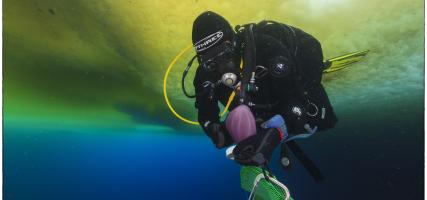
Recherche
Affiner les 47 résultats
, 2017 — Autonomous reef monitoring structures in the Southern Ocean, a tool for the study of the understudied small fauna. , , p. 47-48
, janvier 2017 — Molecular data and ecological niche modelling reveal the evolutionary history of the common and Iberian moles (Talpidae) in Europe. Zoologica Scripta vol. 46, n° 1, p. 12-26
ISSN
0300-3256
, 2017 — North Andean origin and diversification of the largest ithomiine butterfly genus. Scientific Reports vol. 7, ,
ISSN
2045-2322
, 2017 — Ecology, life history, and genetic differentiation in Neotropical Melinaea (Nymphalidae: Ithomiini) butterflies from north-eastern Peru. Zoological Journal of the Linnean Society vol. 179, n° 1, p. 110-124
ISSN
00244082
, février 2017 — New genus and species of cavernicolous cockroach (Blattaria, Nocticolidae) from Vietnam. Zootaxa vol. 4232, n° 3, 4232.3.5
ISSN
1175-5326
, février 2017 — Taxonomy of the Cryptopygus complex. II. Affinity of austral Cryptopygus s.s. and Folsomia, with the description of two new Folsomia species (Collembola, Isotomidae). ZooKeys vol. 658, , p. 131-146
ISSN
1313-2970, 1313-2989
, août 2017 — Evolution of the Sex Chromosomes in Beetles. I. The Loss of the Y Chromosome. Cytogenetic and Genome Research vol. 152, n° 2, p. 97-104
ISSN
1424-8581
, 2017 — Widespread hybridization within mound-building wood ants in Southern Finland results in cytonuclear mismatches and potential for sex-specific hybrid breakdown. Molecular Ecology vol. 26, n° 15, p. 4013-4026
ISSN
09621083
, octobre 2017 — First record of the genus Spinaethorax Papá & Palacios-Vargas, 2016 (Collembola, Neelipleona, Neelidae) in Asia, with a new species from a Vietnamese cave.. European Journal of Taxonomy , n° 363,
ISSN
2118-9773
, 2017 — Fascinantes araignées. , , dir. Quae
ISBN
978-2-7592-2716-7
, 2017 — Judith Najt. A Life dedicated to Collembola and research support for systematics. Zoosystema vol. 39, n° 1, p. 5-14
ISSN
1280-9551
, mars 2017 — Mutualistic mimicry enhances species diversification through spatial segregation and extension of the ecological niche space. Evolution; international journal of organic evolution vol. 71, n° 4, p. 826-844
ISSN
00143820
, mars 2017 — Neanura judithae n sp from Polish Carpathians, with an updated and illustrated key to all species of the genus Neanura MacGillivray, 1893 (Collembola: Neanuridae). Zoosystema vol. 39, n° 1, p. 37-47
ISSN
1280-9551
, 2017 — A list of Yuukianura Yosii, 1955 species of the world (Collembola: Neanuridae: Neanurinae: Lobellini), with description of a new species of unusual ecology from Santo Island (Vanuatu). Zoosystema vol. 39, n° 1, p. 55-67
ISSN
1280-9551
, 2017 — Talpa aquitania sp nov (Talpidae, Soricomorpha), a new mole species from SW France and N Spain. Mammalia vol. 81, n° 6,
ISSN
1864-1547, 0025-1461
, 2017 — Deux nouvelles espèces de Meganebrius Kraatz, 1895, du Népal oriental (Coleoptera, Carabidae). L’Entomologiste vol. 73, , p. 53-59
, 2017 — Découverte du premier Carabique troglobie de Birmanie et descriptions de deux nouveaux Lanxangaphaenops du Laos (Coleoptera, Caraboidea, Trechidae).. Bulletin de la Société Entomologique de France vol. 122, , p. 97-104
, 2017 — Maintaining mimicry diversity: optimal warning colour patterns differ among microhabitats in Amazonian clearwing butterflies. Proceedings of the Royal Society B , ,
, 2017 — The Saturniidae of Barro Colorado Island, Panama: A model taxon for studying the long-term effects of climate change?. Ecology and Evolution vol. 7, n° 23, p. 9991-10004
ISSN
20457758
, 2017 — Scientific abstracts from the 7th International Barcode of Life Conference / Résumés scientifiques du 7 ^{\textrm{e}} Conférence internationale Barcode of Life. Genome vol. 60, n° 11, p. 881-1019
ISSN
0831-2796, 1480-3321






